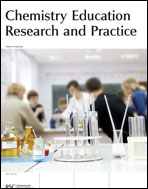Development and validation of an instrument to measure student knowledge gains for chemical and physical change for grades 6–8†
Abstract
Teachers tend to instruct topically, which requires the student to use multiple and interconnected concepts to succeed in each instructional unit. Therefore, it is beneficial to combine research on related concepts to form topic driven instruments to better assist teachers in assessing and instructing students. Chemical and physical change as a topic is often students' first introduction to chemical reactions; however, understanding the distinction is contingent upon a host of advanced ideas. As such, chemical and physical change is best evaluated with a strong emphasis on particle properties and behavior. To date, there was no instrument specifically designed for grades 6–8 (ages 11–14) that focused on the topic of chemical and physical change including its underlying conceptions such as the particulate nature of matter. By making use of well-designed and tested items from previously published research and item repositories, the chemical and physical change assessment (CPCA) was designed to translate findings from research to a practical and classroom-ready assessment. The CPCA went through two versions to result in a 19-item assessment that has generated valid and reliable data to date. Revisions to the assessment were driven by psychometric properties of the items as well as student validation interviews.

 Please wait while we load your content...
Please wait while we load your content...